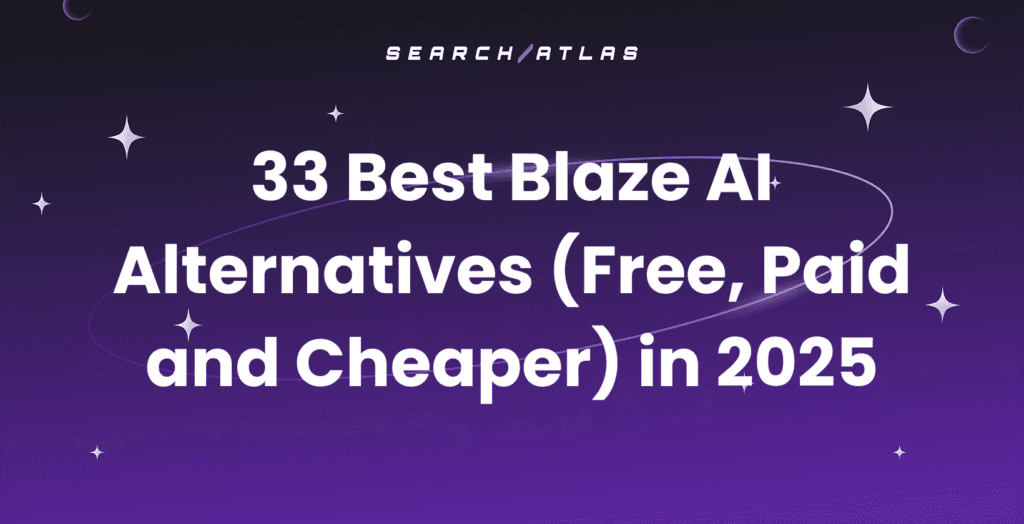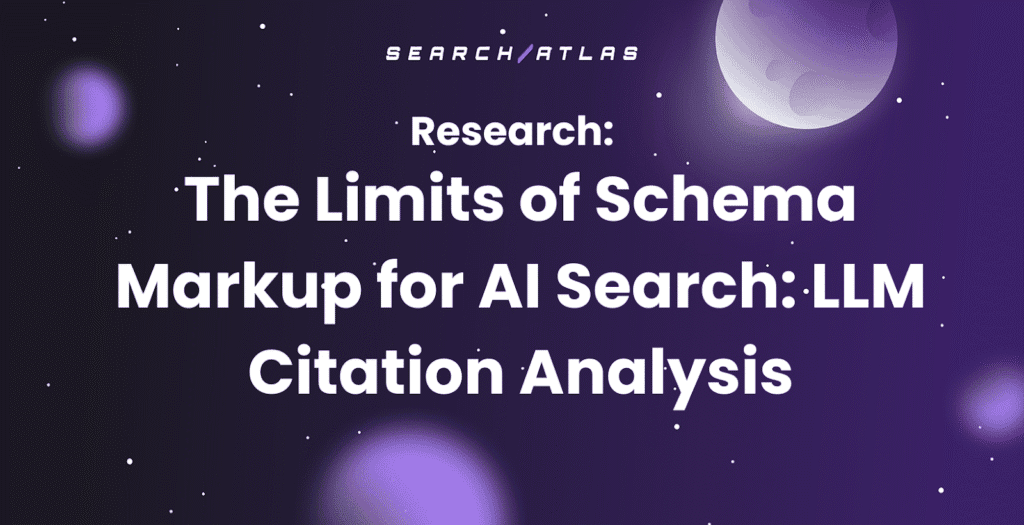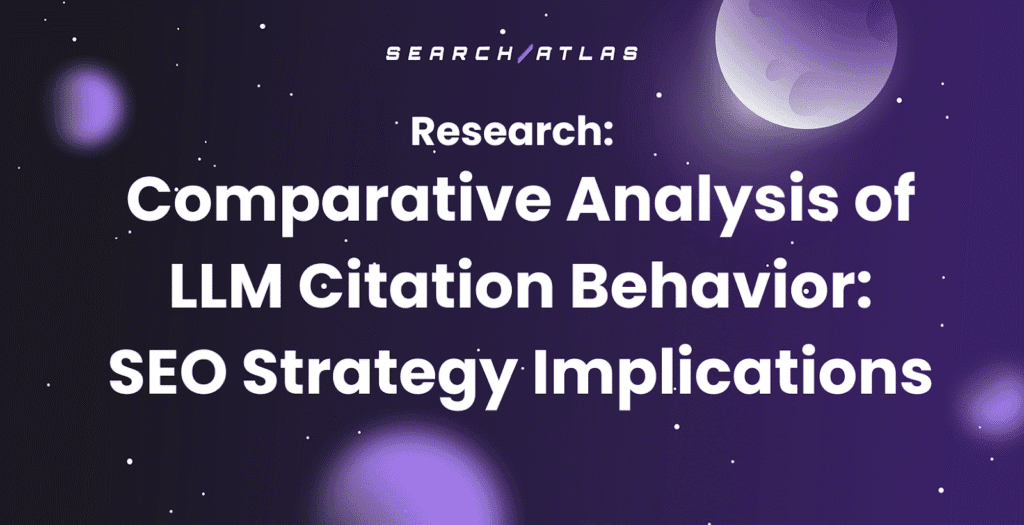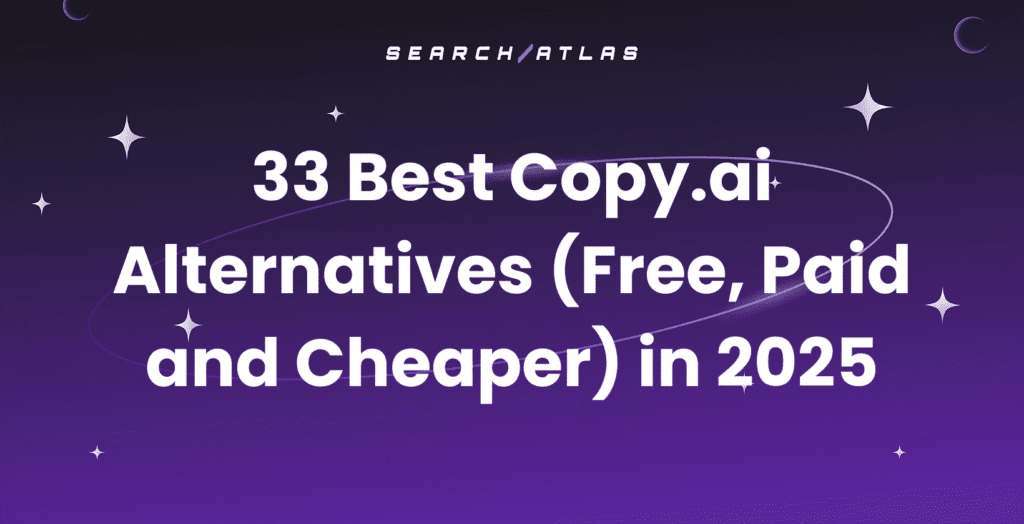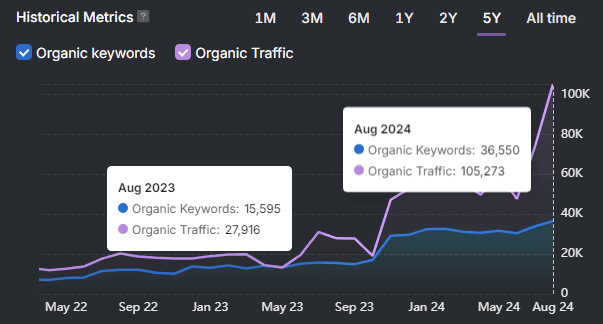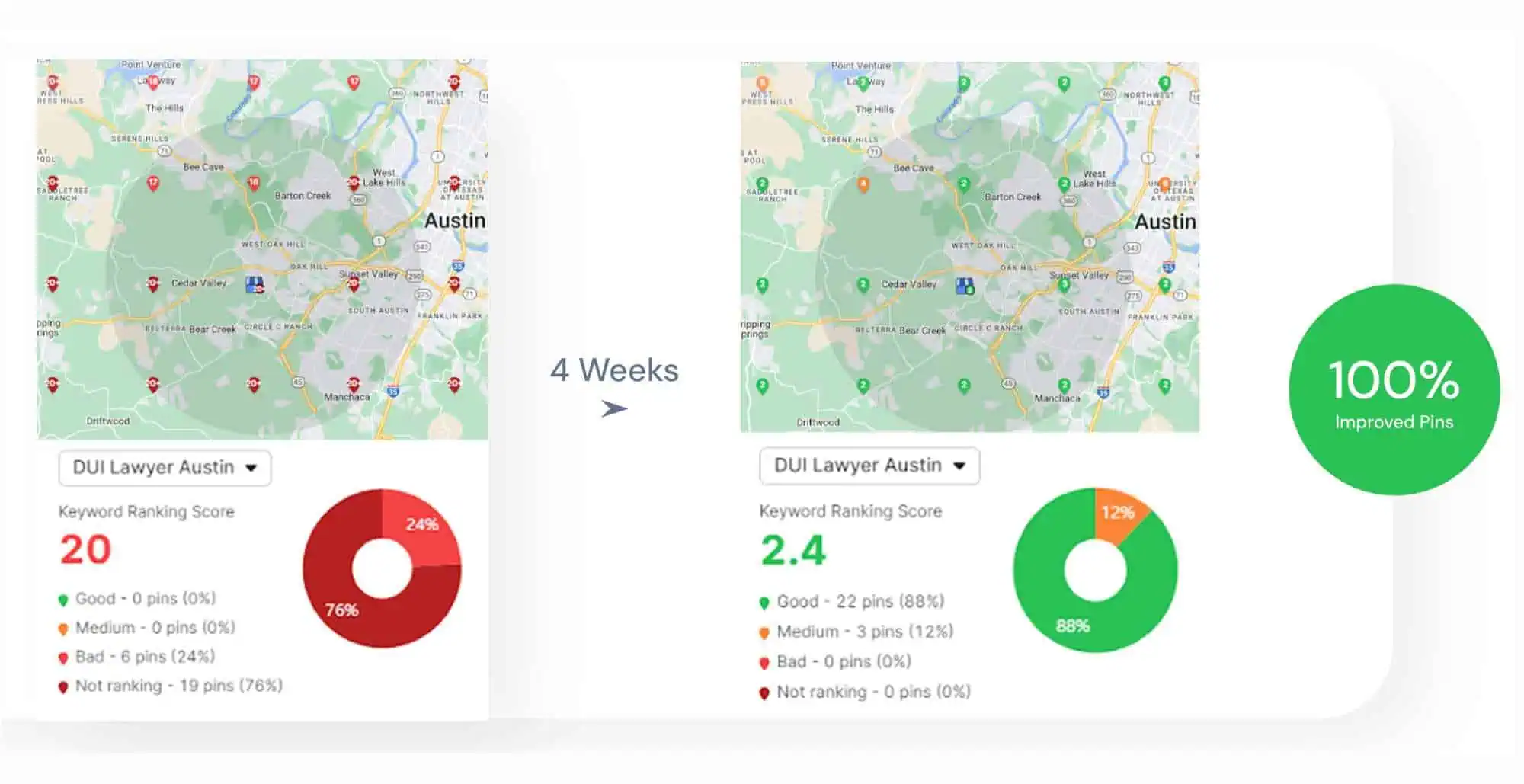The key to creating an SEO-friendly blog is to treat SEO like bookends. It helps shape what you write and ensures it’s optimized when you’re done. You write an SEO-friendly blog post by following best practices while still prioritizing readability and user experience.
Use SEO tools like content planner and content optimizer before you publish to improve readability, keyword placement, and overall structure. Keep reading to find 16 of the best tips for writing SEO-friendly blog posts that rank well and keep readers engaged! 👓
What Is an SEO-Friendly Blog?
An SEO-friendly blog is a blog designed to rank well on search engines and attract the right audience. It uses smart SEO techniques like keyword placement, clear structure, and fast loading speeds to improve visibility.
For example, a travel blog post titled “Best Budget-Friendly Destinations in Europe” ranks higher and reaches more travelers searching for budget trips if it is optimized with relevant keywords, headings, and internal links.
Why Is SEO-Friendly Content Writing Important?
SEO-friendly content writing is important because it makes your blog easier to find. Most people will never see it if it’s buried on page two of Google. A First Page Sage study found that the first result on Google gets 39.8% of clicks, while the tenth gets just 1.6%.
You miss out on traffic, leads, and potential revenue if you don’t rank well.
Unlike ads, investing in SEO best practices is free and keeps bringing traffic long after a paid campaign ends. Good SEO helps solve common marketing challenges, like generating content ideas, increasing engagement, and reaching your audience more effectively.
An SEO-friendly blog is a blog you optimized to rank higher in search results. The better it ranks, the more people will find your business.
With the right SEO strategy, your blog brings you the benefits listed below.
- Boosting brand awareness
- Increasing site traffic
- Generating leads
- Improving conversions
- Driving revenue
Want to make your blog work harder for you? We explain how below. 👇
16 Incredible Tips to Create the Most SEO-friendly Blog
There are countless SEO techniques, but we’re focusing on the most effective ones. For example, using the help of SEO tools and content assistants to optimize your blog without sacrificing quality. We share the 16 most helpful tips below.
1. Choose the Right Keyword to Boost Content Discoverability
Each blog post gives you a chance to rank for relevant keywords. Firstly, start by choosing a target keyword. The target keyword is the main term you want the post to rank for, like “home workout tips” or “dog food.”
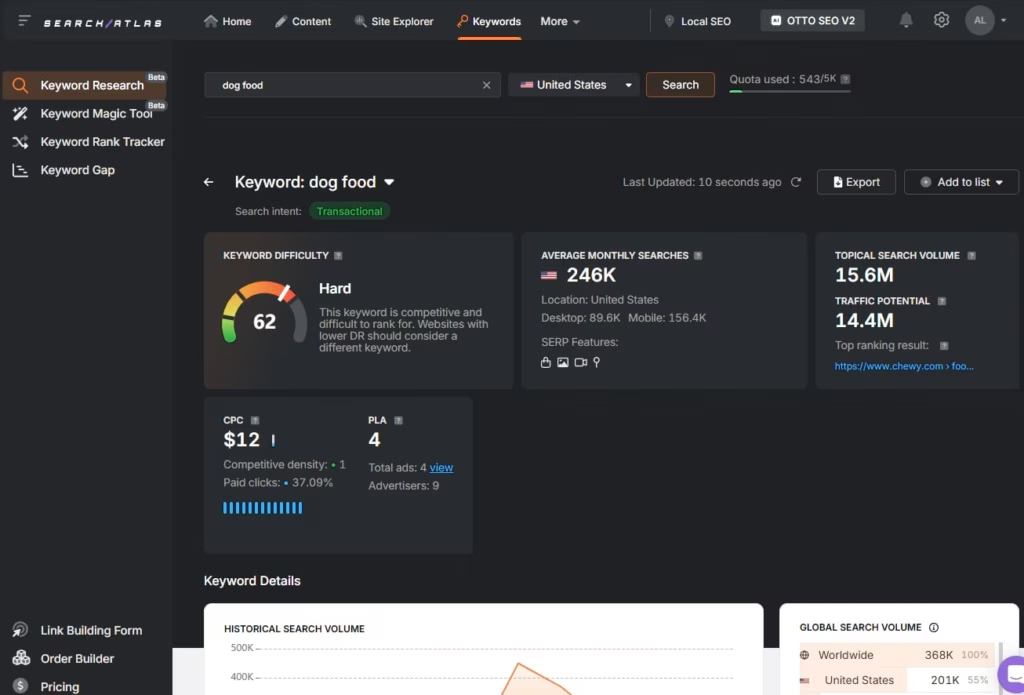
Secondly, optimize your post for the four types of keywords listed below.
- Secondary Keywords. Variations or synonyms of your primary keyword
- Related Keywords. Terms or subtopics connected to your primary keyword
- Long-tail Keywords. Specific keyword phrases with lower search volume but higher intent
- Questions. Common questions people ask about your topic
Your target keyword is the foundation, but posts often rank for many other related terms.
To find a good primary keyword, start with a simple description of your topic. For example, if you’re writing about “healthy eating,” use keyword research tools to see related terms and metrics like search volume and competition level.
2. Use a Content Assistant to Streamline Your Workflow
An AI content assistant is a powerful tool that helps you create optimized content by analyzing top-ranking pages and providing actionable insights. The AI content assistant suggests subheadings, focus keywords, internal links, and even related terms to boost your SEO.
For example, the content assistant might recommend subheadings like “meal planning tips” or suggest keywords like “nutritious recipes” for a blog post about “healthy eating.” The content assistant generates outlines, which makes it easier to organize your content.
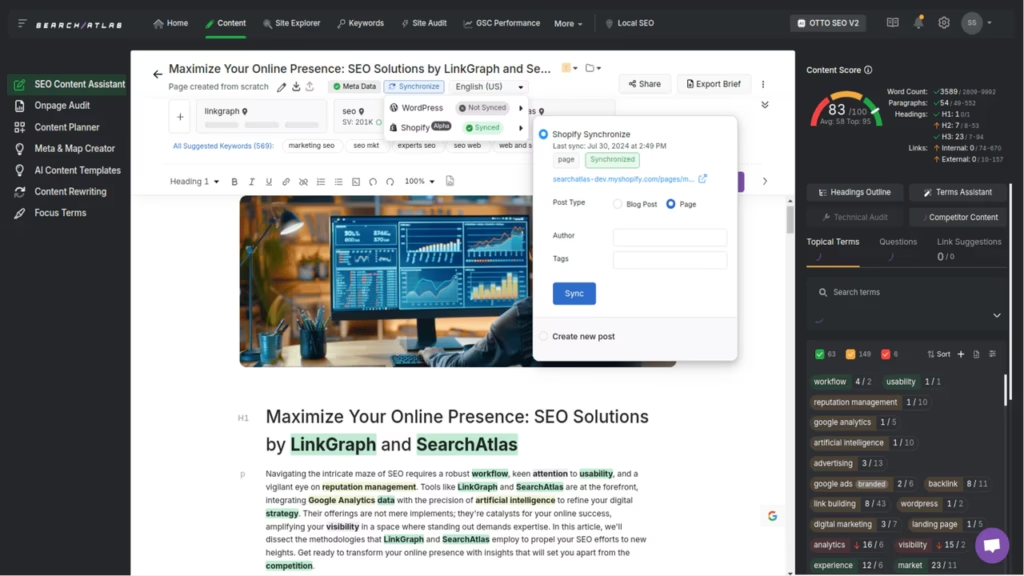
The best content assistant tools offer competitor analysis along with content planning. Competitor analysis lets you see what’s working for others in your niche. Content assistant tools even generate images with AI to enhance your blog posts visually.
You publish with one click, which saves time and ensures your posts go live effortlessly. A content assistant tool is the perfect resource for businesses looking to improve SEO and content efficiency.
3. Explore Content Planners and Topic Maps for a Solid Strategy
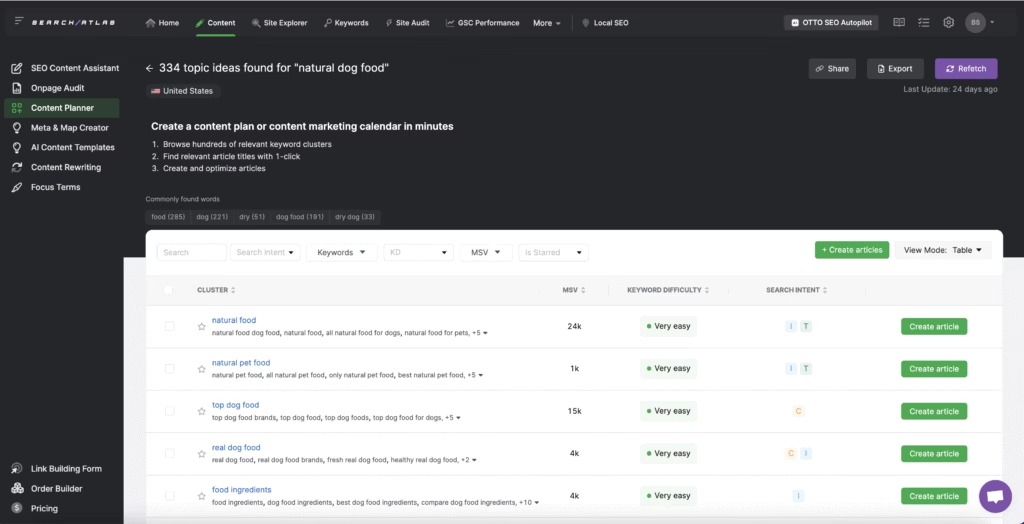
A content planner is a tool that helps you organize and strategize your blog posts to ensure you’re targeting the right keywords and topics. It’s like your roadmap for creating SEO-friendly content.
A content planner lets you identify keyword gaps, track your rankings, find competitor keywords, and see where you need to focus next.
For example, the planner shows that you’re missing content on “social media advertising strategies” or “email marketing tips” when it analyzes your post about digital marketing.
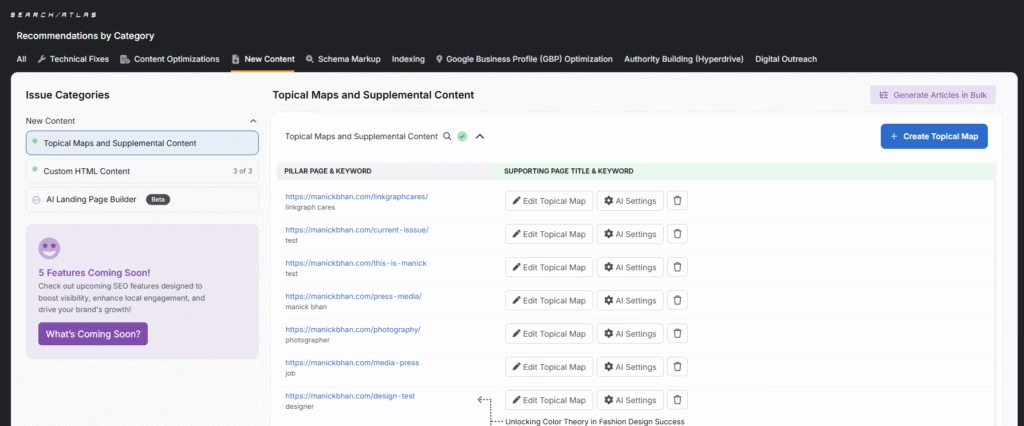
Topical maps are a visual way to organize your content around a central theme. Topical maps look like a web where the main topic is at the center, and all related subtopics branch out. An example topical map for a blog post on healthy eating includes subtopics like “Meal Prep Tips,” “Low-Carb Diet Plans,” and “Nutritional Benefits of Smoothies.”
This method helps you see the full scope of possible content to cover every angle of your chosen topic. The topical map method makes your blog more comprehensive and SEO-friendly.
4. Leverage Scholar to Understand Content Like Google Does
Search Atlas Scholar is a semantic-grader tool that helps you optimize your content to meet Google’s ranking standards. It allows you to see exactly what Google sees, which is critical for improving your rankings.
The tool assigns a score between 0 and 100 to show how well your content is performing, which helps you see exactly where to improve.
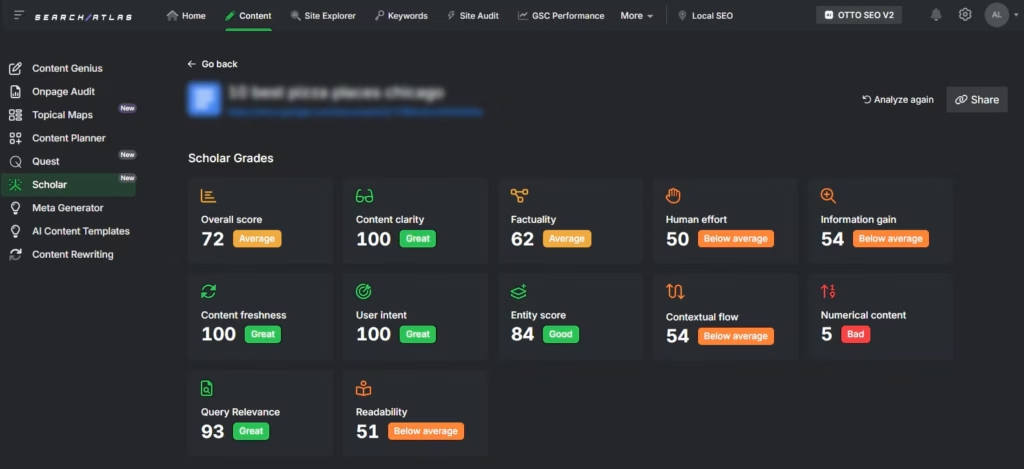
Scholar analyzes content on any website for the metrics listed below.
- Content Clarity. How easy your content is to read, free from jargon.
- Factuality. How accurate and relevant the information is, and how it connects with search queries.
- Human Effort. How much real effort went into creating the content beyond just using SEO tools.
- Information Gain. What new or unique facts your post brings to the table that aren’t already covered elsewhere.
- Content Freshness. How up-to-date your content is to show Google it’s current.
- User Intent Alignment. Whether your content meets the user’s needs and expectations.
- Entities. Are you mentioning the right topics that Google understands?
- Contextual Flow. Does your content flow logically from one point to the next?
For example, imagine you’ve written a blog post on “How to Grow Indoor Plants.” Scholar reviews your content and provides feedback. A low factuality score means you need to fact-check your information to make sure everything is correct.
5. Meet Search Intent to Answer Your Readers Questions
Search intent is the reason behind a user’s query or what they’re hoping to find when they search. To rank well, your blog needs to match that intent.
There are four main types of search intent. The four types are listed below.
- Navigational. The user wants to find a specific website or brand.
- Informational. The user is looking for more information on a topic.
- Commercial. The user is researching a potential purchase.
- Transactional. The user wants to make a purchase or complete a transaction soon.
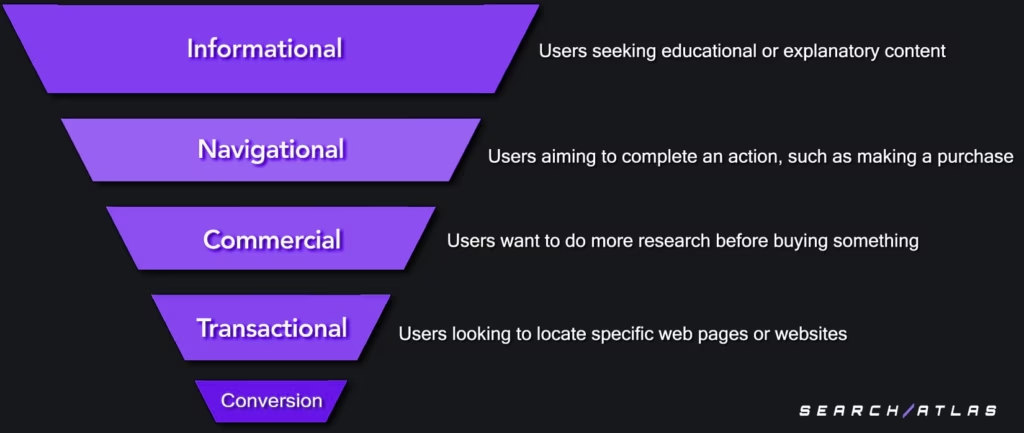
For example, a keyword with informational intent is “how to crate train a puppy.” The intent is informational because the searcher is looking for advice on training. So, Google shows “how-to” blog posts.
On the other hand, a keyword with a mix of commercial and transactional intent is “best crates for puppies.” Google shows comparison guides or product lists to help the user choose.
6. Structure Your Content with Headings
Headings break up your blog post into easy-to-read sections and give you a chance to target secondary and related keywords, which improves your rankings.
A typical H1 through H6 heading structure is described below.
- H1. Main topic or title (with your target keyword)
- H2. Main sections or subtopics
- H3 to H6. Subsections or details under each section
Headings make your content more scannable for readers and help search engines understand the structure of your post. Headings show the depth of your content, which has the potential to improve rankings.
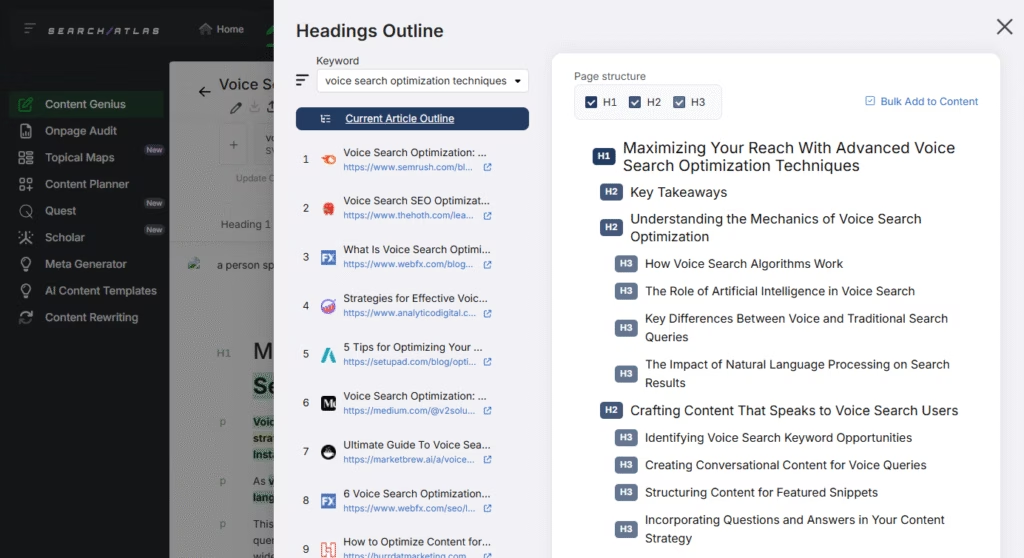
A content assistant tool helps by analyzing the top-ranking pages for your target keyword. A content assistant tool suggests a content outline based on what’s already ranking, including a minimum number of subheadings for each section.
The tool ensures your content is well-structured and aligns with what’s working in search results.
We list four heading optimization tips below.
- Use one H1 tag, matching it with your title.
- Keep a logical hierarchy. H2s below H1, H3s below H2, and so on.
- Include secondary keywords in headings and expand on them in the content.
- Be concise as long headings are hard to scan and read.
7. Incorporate Other Keywords to Avoid Stuffing
To improve your chances of ranking, use both primary and secondary keywords throughout your blog post. The goal of using both primary and secondary keywords is to sound natural and avoid keyword stuffing.
A keyword stuffing example is shown below.
“Buy the best dog leash. A dog leash helps in dog training. A dog leash is perfect for all dogs.”
Do not repeat the primary keyword. Use secondary keywords and related terms. This keeps your content natural while broadening the range of terms Google associates with your post.
A content assistant tool suggests related terms based on what’s ranking at the top for your target keyword. These semantically related terms help increase your topical relevance without overusing the same keyword.
For example, related terms for “dog training” include “puppy obedience” or “training techniques.” This variety helps your content feel more complete and natural.
8. Add Visuals and Multimedia to Engage Users
Adding images, videos, and audio makes your blog post more engaging and helps meet user expectations. In some cases, multimedia is even crucial for ranking high in SERPs.
For example, a blog post about “how to train a puppy” includes step-by-step images to help readers follow along or a Youtube video. These visuals make the post more engaging and they match the user’s intent for a detailed, easy-to-understand guide.
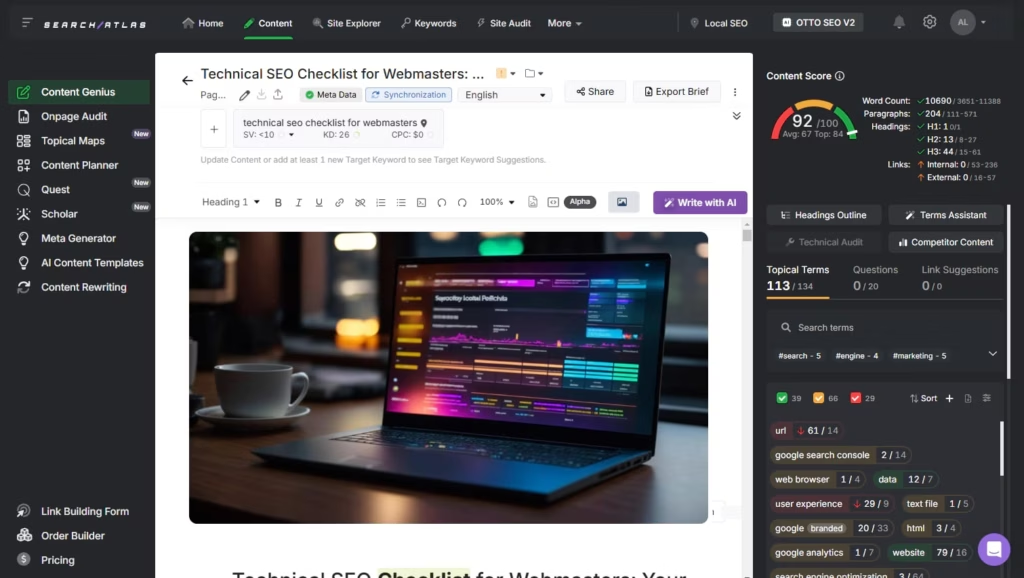
Multimedia helps break up long sections of text, which improves the overall user experience. This indirectly benefits your SEO by encouraging more time on page.
Just be sure that your images and videos don’t slow down your page. One major SEO mistake is forgetting to compress images and use modern formats to keep load times fast. Proper formats and image compression ensure your optimization efforts aren’t hurt.
9. Craft a Compelling Title to Improve Click-Through Rates
Your blog’s title tag is key for both users and search engines to understand what your post is about. The title tag helps determine which keywords your blog ranks for and is often used as the clickable link in search results.
For example, Google displays a title tag that reads “Best Dog Training Tips for New Pet Owners,” in the search results.
Your title plays a big role in attracting clicks. Title tag tips are listed below.
- Keep your title under 60 characters (around 600 pixels), since Google only shows that much.
- Place your primary keyword near the start of the title.
- Ensure each page has a unique title tag to avoid confusion.
- Make your title clear, catchy, and relevant to what users are searching for.

Use a tool to automatically optimize meta tags (title and descriptions). Automatic optimization makes sure they’re SEO-friendly and enticing for users. These tools help streamline the process and fix any issues, which ensures your titles and meta tags are always up to par.
10. Write a Meta Description to Increase Engagement
A meta description provides extra details about your blog post for both users and search engines. It often shows up under your title in search results, giving users a quick preview of what your post covers.
An example meta description for a post on “training a new puppy,” is “Learn the best techniques to train your puppy quickly and effectively.”
Meta descriptions influence clicks. We list a few tips for writing effective meta descriptions below.
- Keep it under 105 characters (around 680 pixels on mobile).
- Include related keywords or variations.
- Make it align with search intent.
- Add a compelling call to action (CTA), like “Find out more” or “Get started today.”
- Use a meta generator.
11. Include an Author Bio to Build Trust
Author bios give readers a quick snapshot of the person behind the blog post, showcasing their expertise and experience in the subject matter.
Typically placed at the end of the post, an author bio schema might look something like this: “Jamie Lovejoy is a certified pet trainer with over 10 years of experience working with dogs.”
Author bios are a great way to demonstrate experience and expertise, which are key quality signals that Google looks for when evaluating content.
To highlight expertise and experience in your author bios, follow the tips listed below.
- Work with industry experts to write your content.
- Include the relevant qualifications of the author, like education or certifications.
- Mention their industry experience and the topics they specialize in.
- Create author pages that link to all the content they’ve written for your site, showcasing their work.

This builds trust with your audience and with search engines and helps your content stand out.
12. Add Expert Insights to Enhance Authority
Including expert insights in your blog posts potentially boosts your website’s credibility and trustworthiness. Expert insights are especially important in an age where a lot of content is generated by AI.
Google uses 4 factors to assess content quality. These are the Google E-E-A-T (Experience, Expertise, Authoritativeness, and Trustworthiness).
To help your content rank higher and stand out, it’s important to showcase these 4 key aspects. We list a few tips on Google E-E-A-T below.
- Invite industry experts to write or contribute to your blog.
- Interview an expert and include their insights in your post.
- Link to authoritative websites, original research, or case studies.
This enhances your content and helps build trust with both users and search engines.
13. Link to Relevant Content to Provide More Value
Internal links point to other relevant blog posts or pages on your website. They help users and search engines find different pages or blog posts within your website.
Internal linking shows that your site covers a variety of useful topics, which is great for both users and search engines.
A few internal linking best practices are listed below.
- Make sure the links are relevant and valuable to the user.
- Use clear, concise anchor text that describes the linked page.
- Avoid linking to pages with 301 redirects, as this confuse search engine bots and users.
- Use automated internal linking.
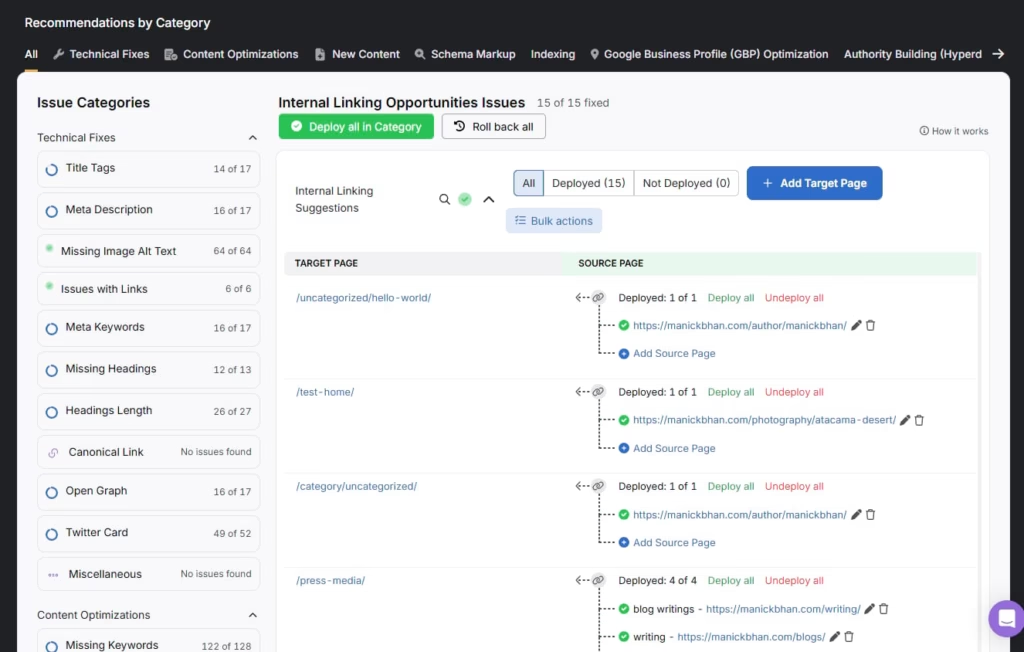
14. Create a Short, SEO-Friendly URL to Improve Visibility
A URL is the web address of a page. The purpose of the URL is to communicate what the page is about and where it fits in your website’s structure.
Content management systems (like WordPress or Shopify) often generate URLs automatically, but these may not be very informative for users or search engines. An example of an automatically generated URL is listed below.
- mydomain.com/post-id?=8394asddkfue
It’s a good idea to customize your URLs for better SEO. A better example is listed below.
- mydomain.com/blog/how-to-train-a-puppy
To create SEO-friendly URLs, follow the steps listed below.
- Use HTTPS for added security (and it’s a Google ranking factor).
- Organize your content with subfolders, like /blog/ for blog posts.
- Keep URLs short and sweet. Long ones are harder to share.
- Include your primary keyword in the URL.
15. Audit Old Content to Prevent Content Decay and Improve Rankings
Old content sometimes stops matching the current search intent or has outdated information. Search engines reward pages which provide relevant and up-to-date information. This is why updated pages retain rankings and consistent updates prevent traffic loss. Pages which remain outdated lose visibility over time. This is called content decay.
Pages with content issues reduce the overall performance of your website. Prevent the decline in performance by deleting them, merging them with other pages, or updating the content.
To identify content decay and poor content, use the Page Pruning Tool. The Page Pruning Tool scans your website for poor content (thin content, low-quality content, content with declining click rates). It gives you actionable tips to fix content decay and other issues.
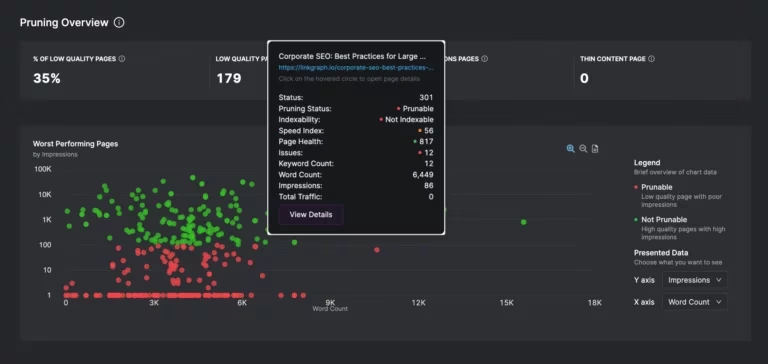
16. Make Your Content Linkable to Boost Authority
Authority measures a page’s credibility based on backlinks. Backlinks are links from other websites that signal trust to search engines. Linkable content (original research, expert insights, valuable resources) attracts these backlinks naturally.
Strong formatting, visuals, and actionable information increase the chances of earning links from other domains. High-authority backlinks improve both search rankings and traffic growth. Search Atlas Link Building tools streamline this process by automating prospecting, outreach, and placement. Search Atlas link building tools connect you to the largest global publisher exchange to boost your site authority.
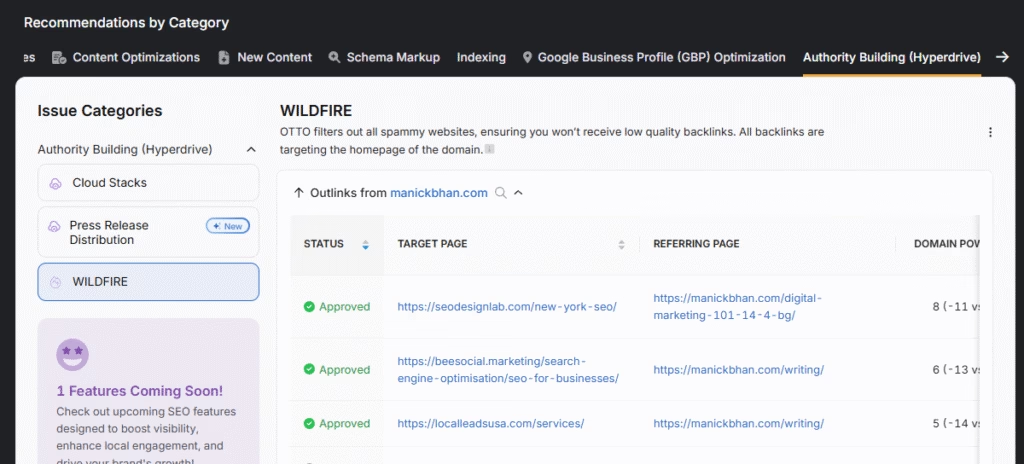
Skip the Hassle: Use Tools to Make Your Blog SEO-Friendly Automatically
While there are numerous SEO techniques to consider, the right tools help you automate almost all of your efforts, which saves valuable time and energy. 💆
For example, Search Atlas’ content assistant Content Genius gives you terms related to your keyword and topic and analyzes competitor outlines one by one. Content Genius reduces manual effort.
Plus, the OTTO SEO tool automates your on-page SEO, meta tag optimization, technical SEO, internal linking, and more.
Why not see how much you automate with OTTO and other innovative tools from Search Atlas? Try our free trial today! ⚡


